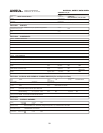
22
CLEANING INSTRUCTIONS (continued)
GRIDDLE CLEANING INSTRUCTIONS
PRECAUTIONS Griddle surfaces are HOT. Wear appropriate heat
protective gloves, apron and goggles
FREQUENCY As Noted
TOOLS Scraper, Pumice Stone or Griddle Brick
Clean Cooking Oil
Mild Detergent, Soft Cloth or Sponge
Plastic Scouring Pad
1. To keep the griddle clean and food flavors at their best, scrape the
griddle after preparing each order. Scrape excess food into the
waste hole in the grease trough (front of the griddle cooking
surface). After each 2 - 3 orders, wipe the griddle surface with a
light coat of oil.
2. Clean the griddle surface daily, at a minimum:
a. Keep the ventilator fan
ON.
b. Set griddle temperature control to 220ºF. Allow the griddle
temperature to drop to 220ºF before proceeding.
c. Pour a small amount of water on the griddle surface and let it
"sizzle".
d. Use a pumice stone or griddle brick to remove all remaining
waste, and to clean the griddle surface down to bright metal.
Wipe off any remaining powder residue.
e. Use a soft-bristled fiber brush in a circular motion to remove any
remaining food particles.
f. Turn temperature control to OFF. Allow the griddle surface to
cool, then wipe the surface with a clean cloth.
g. Dry the griddle surface thoroughly.
h. Season the cooking surface after each cleaning using the
instructions on page 10.
3. At least once each day, the GREASE TROUGH must be
thoroughly cleaned. Using a scraper, remove all grease and
food waste from the grease trough and into the grease drawer.
4. After scraping all cooking waste from grease trough into GREASE
DRAWER, take the grease drawer to kitchen cleaning area and
properly dispose of all waste.
a. Clean drawer with hot water and a mild detergent.
b. Dry drawer thoroughly and reinstall in griddle.
5. GRIDDLE EXTERIOR:
a. Wipe down splash guards, griddle body and the grease trough
with a cloth dampened with warm water and a mild detergent.
b. A plastic scouring pad and a non-abrasive cleanser may be
used for hard-to-remove food particles.
c. Rinse thoroughly with clean water. DO NOT splash or pour
water onto control panel or wiring.
d. Dry griddle with a soft, clean cloth.
CAUTION:
HOT SURFACE
Exposed surfaces can be hot
to the touch and may cause
burns.
CAUTION:
ELECTRICAL
SHOCK
HAZARD
DO NOT splash or pour water
onto control panel or wiring.
CAUTION:
HEAT AND SMOKE
HAZARD
Keep the ventilator fan
running during any "hot
surface" cleaning operation to
avoid a build-up of heat and/
or smoke.
IMPORTANT: Avoid Fire
Suppression System
discharge!
Keep the ventilator fan
running during any "hot
surface" cleaning operation to
avoid melting a fusible link
and causing a discharge of
the fire suppression media.


















